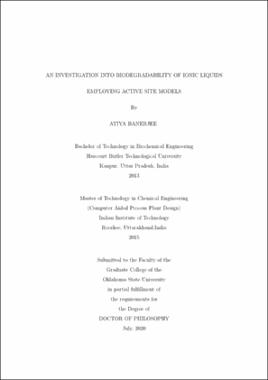| dc.contributor.advisor | Shah, Jindal K. | |
| dc.contributor.author | Banerjee, Atiya | |
| dc.date.accessioned | 2021-02-22T22:24:18Z | |
| dc.date.available | 2021-02-22T22:24:18Z | |
| dc.date.issued | 2020-07 | |
| dc.identifier.uri | https://hdl.handle.net/11244/328628 | |
| dc.description.abstract | Ionic liquids have the potential for driving industrial processes in a sustainable fashion due to their environmentally benign characteristics like inherent low vapor pressure and flammability. Their extremely low vapor pressures translate to the fact that they have negligible role in air emissions as compared to conventional industrial solvents. Ionic liquids can also be flexibly designed in order to obtain desirable physical properties. This design could be carried out by choosing from thousands of possible combinations of cations and anions. Out of the myriad of a wide range of ionic liquid classes, imidazolium-based ionic liquids have been the most successfully utilized in diverse applications. Suitable variants of this type of ionic liquid have been applied in catalysis, extractive distillation, liquid-liquid extraction among many others. Though being proved to be highly effective in driving complex industrial processes, experimental investigations have raised questions on their environmental degradability. Thus, it becomes imperative to include rational design into their synthesis. From an experimental point of view, considerable efforts have been put in this direction but molecular level details have not been explored in detail computationally. The present work aims to provide physical insight into the phenomena of ionic liquid biodegradability to aid in the future design of these solvents. | |
| dc.description.abstract | Cytochrome P-450 has been identified and widely studied for their role in oxidation of a wide variety of molecules in aerobic and anaerobic environments. Thus, to develop a computational framework related to biodegradability, it was considered important to capture the effects of the cytochrome on imidazolium-based ([Cnmim]+) and other cations for which biodegradability has been studied. For this, the enzymatic center of the P-450 molecule (heme) was modeled as an iron porphyrin molecule and enhancing the complexity of the active site at every step. The [Cnmim] cation was included in the model as a potential substrate for the P-450 enzyme in complexation with the heme receptor. This interaction was firstly modeled using DFT calculations by adapting a purely quantum mechanical framework to provide insight into geometrical and electronic properties of the complex arising from different conformations. In the next step, the entire catalytic cycle of the P450 was treated using a synchronous approach using pure DFT modeling technique. To include favorable conformations in the presence of the protein environment, docking calculations were performed that elucidated the plasticity of the binding pocket. The docked structures were then subjected to QMMM calculations and the resulting geometries were analysed. | |
| dc.format | application/pdf | |
| dc.language | en_US | |
| dc.rights | Copyright is held by the author who has granted the Oklahoma State University Library the non-exclusive right to share this material in its institutional repository. Contact Digital Library Services at lib-dls@okstate.edu or 405-744-9161 for the permission policy on the use, reproduction or distribution of this material. | |
| dc.title | Investigation into biodegradability of ionic liquids employing active site models | |
| dc.contributor.committeeMember | Fahlenkamp, Heather | |
| dc.contributor.committeeMember | Andiappan, Marimuthu | |
| dc.contributor.committeeMember | Borunda, Mario | |
| osu.filename | Banerjee_okstate_0664D_16882.pdf | |
| osu.accesstype | Open Access | |
| dc.type.genre | Dissertation | |
| dc.type.material | Text | |
| dc.subject.keywords | biodegradability | |
| dc.subject.keywords | cytochrome p-450 | |
| dc.subject.keywords | dft | |
| dc.subject.keywords | docking | |
| dc.subject.keywords | ionic liquids | |
| dc.subject.keywords | qmmm | |
| thesis.degree.discipline | Chemical Engineering | |
| thesis.degree.grantor | Oklahoma State University | |
